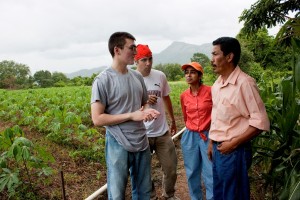
Richard Durham ’11, Luke Calvano ’12, and Anuradha Ghai, lecturer in economics, speak with Sergio Aguilar, regional director of the Honduran Coffee Board, in the coffee fields.
A feature-length article in The Chronicle of Higher Education highlights the multidisciplinary approach Lafayette’s Economic Empowerment and Global Learning Project (EEGLP) takes toward its community redevelopment initiatives.
Read the article
EEGLP brings together students and faculty from Lafayette’s four academic divisions of engineering, humanities, natural sciences, and social sciences to work hand in hand with villagers and residents to tackle real world economic issues on the local, national, and international levels. For the last four years, the team has helped villagers in Lagunitas, Honduras, improve their economy through coffee farming and production; residents of the hurricane ravaged Lower Ninth Ward of New Orleans work toward “green” community renewal; and Easton residents to form a plan to build a community center for arts and cultural activities. A new project in Jamaica is also set to begin soon.

David Veshosky (left), associate professor of civil and environmental engineering, and Donald Ellis ’11 (right) discuss renovations in New Orleans.
The article praises EEGLP’s “work as a way to connect to outside constituencies and to demonstrate the value of a liberal-arts education,” and quotes numerous students and faculty including Provost Wendy Hill, Gladstone Fluney Hutchinson, associate professor of economics and EEGLP founder, and President Daniel H. Weiss.
“One of the intellectual strengths of the Lafayette projects, Mr. Hutchinson argues, is bringing together students from various backgrounds and disciplines, who contribute different skills and can challenge one another’s ideas. Among the Honduras team members, for example, are [Richard] Durham [’11], a double major in economics and Spanish, and Hannah Rhadigan [’11], who is earning a degree in studio art. She took her camera to Lagunitas, and her powerful portraits, dignified and haunting, are used to illustrate the effort’s effect in presentations and publications.”

Gladstone Fluney Hutchinson, associate professor of economics and EEGLP founder, Richard Durham ’11, and Sergio Aguilar, regional director of the Honduran Coffee Board, gather supplies in town.
In Honduras, the students helped the villagers build a 30,000-plant coffee plantation, half of which has been harvested last year. They also hosted Sergio Aguilar, regional director of the Honduran Coffee Board, during a weeklong trip to meet with prospective coffee importers in New York City. In New Orleans, the group has helped residents work toward their goal of rebuilding as the first carbon-neutral community in the country. Projects include the use of solar energy, establishing urban farms, designing a town center shopping area using green technology, and transforming the run-down Louis Armstrong School into a center for arts and culture. Locally, in Easton, the team has put together an economic impact analysis and preliminary engineering and design work for the Governor Wolf Art and Culture Athenaeum project.
The article highlights not just the benefits this work provides for the communities, but also the academic and professional skills the students are gaining.
“In fact, Jon Martin [’11], a civil engineering student, says his experience working on sustainable housing in New Orleans is more meaningful because of its real-world impact. ‘It motivates me more than any grade in a class would,’ he says, adding he had just pulled an all-nighter on a community-based project.”
***
“Ryan Flaherty is one of three engineering students who spent this past summer drawing up plans to turn the uninspiring office space, where drop ceilings and linoleum tiles obscure the building’s old bones, into a regional arts center, with galleries, an auditorium, and a striking glass entryway. A senior, he was told on a recent job interview that his Easton experience is ‘exactly what we want’ in new hires.
“Other students, too, attest to the intellectual impact of the work. Mr. Durham hopes to return to Honduras through a Fulbright grant after graduation. Ting Chiu [’11], a member of the Easton and New Orleans groups, earned a prestigious undergraduate public-policy fellowship at Princeton University this past summer. Another New Orleans team member, Katrina Ladd [’11], a psychology major, designed an independent-study program based on her experience in the city, looking at the ‘collective id’ and how communities can be brought together around common goals.”
Other examples of interdisciplinary learning at Lafayette were also featured in the article.
“The benefits of interdisciplinary and community-based learning and research are emphasized in the college’s strategic plan, says Wendy L. Hill, provost and dean of the faculty. Professors are encouraged to team teach—[Ed] Kerns, [Clapp Professor of Art], for example, led a course in art, neuroscience, and consciousness with a colleague from the biology department.
“And the college has numerous opportunities for students to engage in applied learning. Its ‘tech clinics’ assign groups of students from different majors to specific problems in the community or on campus, such as how to make use of uneaten food at the dining halls. Lafayette’s Landis Center matches students with service-learning opportunities.
“Liberal-arts colleges should be good at this type of learning, Ms. Hill argues, because of their mission to turn out students who can think broadly and deeply. ‘It’s at the core of a liberal-arts education,’ she says.”



1 Comment
Comments are closed.